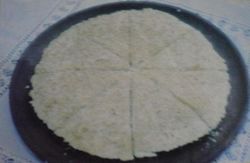
Mbeju
Encyclopedia

Starch
Starch or amylum is a carbohydrate consisting of a large number of glucose units joined together by glycosidic bonds. This polysaccharide is produced by all green plants as an energy store...
cake sometimes made with fariña
Cassava
Cassava , also called yuca or manioc, a woody shrub of the Euphorbiaceae native to South America, is extensively cultivated as an annual crop in tropical and subtropical regions for its edible starchy tuberous root, a major source of carbohydrates...
or manioc flour.
The high-calorie mbeju is a staple of the Paraguay
Paraguay
Paraguay , officially the Republic of Paraguay , is a landlocked country in South America. It is bordered by Argentina to the south and southwest, Brazil to the east and northeast, and Bolivia to the northwest. Paraguay lies on both banks of the Paraguay River, which runs through the center of the...
an diet. According to scholars of Paraguayan social history, the popular Paraguayan diet evolved as a result of the War of Paraguay in the nineteenth century. In the aftermath of the war, food supplies were hard to find. As a result, Paraguayan cooking developed highly nutritious meals to make up for the scarcity of everyday meals.
Origin of the name
The name "mbejú" (also written "mbeyú") means "cake" and comes from the Guarani languageGuaraní language
Guaraní, specifically the primary variety known as Paraguayan Guaraní , is an indigenous language of South America that belongs to the Tupí–Guaraní subfamily of the Tupian languages. It is one of the official languages of Paraguay , where it is spoken by the majority of the population, and half of...
. Guarani is one of the two official languages of Paraguay, which defines itself as being bilingual and multi-cultural. The mbejú is bound to the Guarani mythology
Guaraní mythology
The Guaraní people live in south-central part of South America, especially in Paraguay and parts of the surrounding areas of Argentina, Brazil, and Bolivia.-Overview:There exist no written records of the ancient myths and legends associated with the Guaraní people...
to be one of the most ancient recipes of this culture. Thraditionally, there were about 16 ways to prepare it, although nowadays, 11 are recognized. Next to the chipá and the sopa paraguaya
Sopa paraguaya
Sopa paraguaya is a traditional Paraguayan food. Literally meaning "Paraguayan soup", sopa paraguaya is similar to corn bread. Corn flour, pig fat, cheese and milk or whey are common ingredients. It is a spongy cake rich in caloric and protein content....
it is part of the so-called "tyra", a Guarani term for food consumed to accompany the "mate cocido
Mate cocido
Mate cocido is an infusion typical of Southern Cone cuisine . It is traditionally prepared by boiling yerba maté in water, then strained and served in cups. It is a bitter tasting beverage, similar to mate but softer, with the same stimulating and nutritional properties...
", milk or coffee, or simply an addition to other dishes.
Ingredients
Traditional mbejú require starch, corn flour, eggs, pork fat, thin salt, fresh cheese and milk. The variety called "mbejú avevo" ("inflated cake") uses the same ingredients but with the pork fat, the eggs and the cheese in larger quantities. Another variant, "mbejú de fariña" substitutes manioc flour for starch.Preparation

A greased frying pan is allowed to get very hot. A layer of the mixture of about 1½ centimeters is put into the pan, squeezing the borders with the back of a spoon. It is cooked for a few minutes, moving the pan so it cooks evenly without burning the center. Using the lid of the pan, flip the mbejú, finishing the cooking the same way as above.

